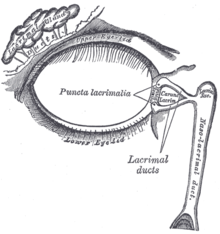User:MGualdoni/crying
Coming Improvements[edit]
I have started to read up about crying and hope to improve this article. I hope to add a new section that explains the biological process that takes place when an individual cries and explain the difference between positive emotion crying and negative crying. Also I hope to expand on the Function section and better explain what crying actually accomplishes. Those two sections will probably be the two that have a majority of the information I will add, but I will also probably add information in other sections when appropriate and possibly address some concerns listed here if I can find the right sources. One last improvement I hope to make is with the pictures in the article; four pictures of people crying seems a little redundant, so I am hoping to find a diagram that shows what happens in your body or in your brain when you cry. If anyone can help with any of this, or if someone happens to stumble upon a source that seems good that you don't feel like reading, passing it my way would be greatly appreciated!
Here is the list of sources I have right now that I will be using for this article. I am still looking for more, so let me know if anyone has any ideas.
Tel Aviv University. "Why Cry? Evolutionary Biologists Show Crying Can Strengthen Relationships." ScienceDaily, 7 Sep. 2009. Web. 1 Jul. 2011.
Katz, Jack. How Emotions Work. Chicago: Univ. of Chicago, 1999. Print.
Lutz, Tom. Crying: the Natural and Cultural History of Tears. New York: W.W. Norton, 1999. Print.
--MGualdoni (talk) 23:32, 1 July 2011 (UTC)
Categorizing Dimensions[edit]
There have been many attempts to differentiate between the two distinct types of crying (one negative and one positive). Different perspectives have been broken down into three dimensions to examine the emotions being felt and also to grasp the contrast between the two types.[1]
Spatial perspective explains sad crying as reaching out to be "there," such as at home or with a person who may have just passed away. In contrast, joyful crying is acknowledging being "here." It emphasized the intense awareness of one's location, such as at a relative's wedding.[2]
Temporal perspective explains crying slightly different. In temporal perspective, sorrowful crying is due to looking to the past with regret or to the future with dread. This illustrated crying as a result of losing someone and regretting not spending more time with them or being nervous about an upcoming event. Crying as a result of happiness would then be a response to a moment as if it is eternal; the person is frozen in a blissful, immortalized present.[3]
The last dimension is known as the public-private perspective. This describes the two types of cryings as ways to imply details about the self as known privately or one's public identity. For example, crying due to a loss is a message to the outside world that pleads for help with coping with internal sufferings. Or, as Arthur Schopenhauer suggested, sorrowful crying is a method of self-pity or self-regard, a way one comforts oneself. Joyful crying, in contrast, is in recognition of beauty, glory, or wonderfulness.[4]
Lacrimal System[edit]

There are three types of tears: basal tears, reflexive tears, and psych tears. Basal tears are produced at a rate of about 1 to 2 microliters a minute, and are made in order to keep your eye lubricated and smooth out irregularities in the cornea. Reflexive tears are tears that are made in response to irritants to your eye, such as when chopping onions or getting poked in the eye. Psych tears are produced by the lacriminal system and are the tears expelled during emotional states.[5]
The lacrimal system is made up of a secretory system, which produces tears, and an excretory system, which drains the tears. The lacrimal gland is primarily responsible for producing emotional or reflexive tears. As tears are produced, some fluid evaporates between blinks, and some is drained through the lacrimal punctum. The tears that are drained through the punctum will eventually be drained through the nose. Any excess fluid that did not go into the punctum will fall over the eye lid, which produces tears that are cried.
References[edit]
- ^ Katz, Jack (1999). How emotions work. Chicago [u.a.]: Univ. of Chicago Press. p. 182. ISBN 0-226-42599-1.
- ^ Katz, Jack (1999). How emotions work. Chicago [u.a.]: Univ. of Chicago Press. p. 182. ISBN 0-226-42599-1.
- ^ Katz, Jack (1999). How emotions work. Chicago [u.a.]: Univ. of Chicago Press. p. 182. ISBN 0-226-42599-1.
- ^ Katz, Jack (1999). How emotions work. Chicago [u.a.]: Univ. of Chicago Press. p. 182. ISBN 0-226-42599-1.
- ^ Lutz, Tom (1999). Crying : the natural and cultural history of tears (1. ed. ed.). New York: W. W. Norton. p. 68. ISBN 0-393-04756-3.
{{cite book}}:|edition=has extra text (help)
